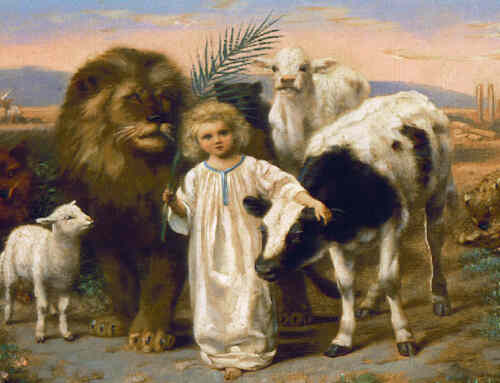There are many lessons for us in this curious account found in both Matthew 15 and Mark 7. A Gentile woman did not accept a seeming denial from Jesus when she asked for her daughter to be healed.
Jesus had ventured into the non-Jewish territory of Tyre and Sidon to rest. After he entered a house in which to find that rest, a loud and emotional woman showed up, begging and yelling to see Jesus. Her daughter was demon-possessed, and she was at her wits end. She knew Jesus unexpectedly coming to her hometown was the one chance she had to rid her child of this evil experience. She wasted no time and expended all of her desperate energy to get his attention. He just had to help! The woman does get to talk to Jesus, and in the end, he does heal her daughter.
Here is the Matthew account from the New Living Translation so we can follow what happened: 21 Then Jesus left Galilee and went north to the region of Tyre and Sidon. 22 A Gentile woman who lived there came to him, pleading, “Have mercy on me, O Lord, Son of David! For my daughter is possessed by a demon that torments her severely.” 23 But Jesus gave her no reply, not even a word. Then his disciples urged him to send her away. “Tell her to go away,” they said. “She is bothering us with all her begging.” 24 Then Jesus said to the woman, “I was sent only to help God’s lost sheep—the people of Israel.” 25 But she came and worshiped him, pleading again, “Lord, help me!” 26 Jesus responded, “It isn’t right to take food from the children and throw it to the dogs.” 27 She replied, “That’s true, Lord, but even dogs are allowed to eat the scraps that fall beneath their masters’ table.” 28 “Dear woman,” Jesus said to her, “your faith is great. Your request is granted.” And her daughter was instantly healed.
It is important to remember that Jesus could read the heart, and he often used this ability to draw out the person’s character.
To call someone a “dog” meant to give them a very pointed and harsh label. In the ancient Jewish culture, dogs were unclean animals. They roamed wild on the streets. They were undesirable scavengers, considered dangerous and often carried diseases. It certainly was not a nice thing to label anyone! Calling someone a “dog” in the New Testament was meant to warn of and acknowledge the brazen, unclean and dangerous characteristics of a wild dog. For example, the Apostle Paul called false teachers “dogs” in Philippians 3:2.
But Jesus did not use a racial slur. He was not labeling the woman as brazen, dangerous or unclean. We know this because Jesus used a different word – this specific Greek word for “dog” is ONLY used in the Matthew and Mark accounts of this event and means a puppy, or little dog. (Strong’s Exhaustive Concordance, Greek word #2952).
This word has the thought of a cared-for family pet rather than a harsh term for a wild dog. Jesus used the metaphor of children and pets living in the same household. Both are cared for, but the children are the priority of the parents. This was a metaphor the woman would have understood far more clearly than his own disciples! Here Jesus is talking to a Gentile woman from a culture who allowed dogs in their homes as pets. The apostles would not have understood it as clearly because for the Jews, unclean animals under the Law – such as dogs – would not have been allowed in the house. Dogs were not pets to the ancient Jews. In ancient Jewish culture, dogs were wild – an animal that roamed outside, out of control, a scavenger that carried diseases.
Jesus is talking to a woman who would have understood having puppies in the house that waited beneath the table for crumbs to fall. He is not being biased or racist – he is being compassionate and explaining to her an important concept. Matthew 15/Mark 7 (NASB): Yet he answered and said, Let the children be satisfied first. It is not good to take the children’s bread and throw it to the dogs.
There was no dog food back then – puppies ate what the people ate! Let the children be satisfied first – this implies there is a “second” or a “next.” They were first but not exclusive. This would have given her hope and an opening to keep the conversation going. To better understand biblical accounts, we have to ask questions like: Who is talking? To whom are they talking? What is the context of the conversation? What are their life experiences? Are they under Jewish Law or not? By answering such questions, we see an extremely compassionate Jesus and an amazing woman. Jesus is teaching her that the children (the Jewish nation) must be “fed” first while she and her daughter (Gentiles) would be “fed” later.
The message of Jesus during his earthly ministry was to primarily go to the Jewish nation (Matthew 10:5-6). They were supposed to be following God’s Law, and therefore were those God would deal with first. The followers of Jesus were bound by this limitation of only going to fellow Jews. This might seem racist in our time, but it is not. Anyone wishing to be part of God’s chosen people could become a Jew, a “proselyte.” But most people were not interested, as Jewish life was too restrictive for them. Most Gentiles looked down on the Jews. Far from being high and mighty, the Jews were outcasts.
Jesus was not limited to serving only the Jews, though he knew he was to go to the Jewish nation first. He knew the Gentile world would eventually be called to follow him. He knew the prophecies and stepped over this exclusive line several times in his ministry to illustrate this.
The order of the gospel message was first to Jerusalem, then to all of Judea (Israel), then to Samaria (a Gentile nation) and finally, to the remotest part of the earth.
Jesus was showing kindness and respect by even talking to this woman and explaining the way the gospel was unfolding. He WAS interested in her and engaging in conversation, drawing her out. Back to the account: Matthew 15/Mark 7: (NASB) “But she answered and said to him, Yes, Lord, but even the dogs under the table feed on the children’s crumbs.” This woman is quick and is clever enough to find a place for herself and her daughter in this allegory of Jesus. Jesus gave her that opening, and she took it. Here is where we see the compassion of Jesus – there is no racism or bigotry. He raises her up to a higher level of understanding.
Additional Resource:
Christian Questions Podcast
Episode #1183: “Who Successfully Challenged Jesus?”
Preview Video
CQ Rewind Show Notes












